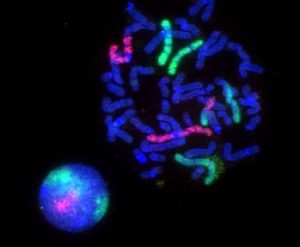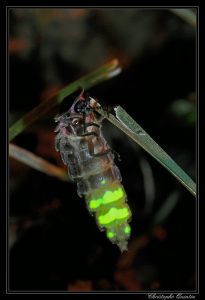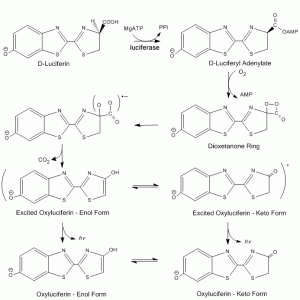Have you ever seen fireflies in your childhood? It’s hard to see them now, but I am still very interested in them.
Why do fireflies shine?
The scientists found that the bioluminescence of the firefly’s abdomen has a small aperture of the luminescent layer. This luminous layer contains thousands of light emitting cells. In the light emitting cell, it contains two kinds of chemicals, one is called fluorescein, another kind is called luciferase. Fluorescein can react with oxygen in the air, release energy in form of photons and emit fluorescence in the catalysis of luciferase. In specific, magnesium and ATP combine with luciferase and the protein luciferin. This combination creates a very excited molecule. When oxygen is introduced into the mix, the excited molecule goes from excited state back to a stable state. This procedure releases energy and creates light. Therefore, firefly luminescence is caused by chemical reactions.
Why do fireflies shine off and on?
The mechanism that turns on and off this light show is still the topic of some debate. The prevailing theory revolves around the firefly’s ability to control oxygen within trachea. When oxygen is abundant, the reaction is intense and the light is strong; When the oxygen is not sufficient, the reaction is slow, the light will be weak or even bleak. There is a high-energy compound called adenosine triphosphate (ATP) in fireflies, which, when the light is weak, more ATP will be released by Mitochondria (the organelle that controls ATP production), and interact with fluorescein, so fireflies can glow again.
Do fireflies burn themselves?
The lighting reaction released almost all the energy in form of light, only a few in the form of heat release, so the fireflies light belongs to cold light. Therefore, fireflies won’t burn themselves due to overheating. Fireflies are more than 95% efficient in making this cold light.
Fireflies and bionics
Firefly has many beautiful fluorescent colours, like light green, light red and pale blue. The difference in colours are highly related to the type of fluorescence in the body. According to this feature, scientists have developed many applications based on the luminescence mechanism of fireflies. In medical science, scientists extract fluorescein from fireflies and use it in the study of cancer cells. By observing the glow of fluorescein placed in cells, they are able to judge the growing speed and growing environment of cancer. In industry, water pollution can be monitored with the help of fluorescein. The luminescence mechanism can be used in more area, because it is very simple and effective. What’s more, there are already a considerable amount of applications of cold light source, such as the flashlight for underwater operation. Cold light source can greatly improve the efficiency of converting chemical energy into light energy, so it can be developed further and applied to other aspects in our life.

Fluorescence microscopy images of sun flares pathology in a blood cell showing the affected areas in red.
-Olivia Yang-


